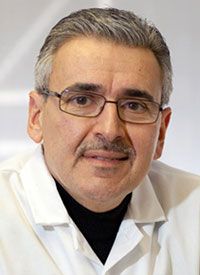Article
Prognostic and Predictive Assays Guide Therapy Decisions in Breast Cancer
Author(s):
Joseph A. Sparano, MD, discusses using gene expression profiles as a means to guide therapy in breast cancer.
Joseph A. Sparano, MD, associate professor of oncology and urology at Johns Hopkins Medicine

Joseph A. Sparano, MD
The use of genomic profiling can provide useful insight to choosing optimal treatment strategies for patients with breast cancer, explained Joseph A. Sparano, MD.
“The integration of the clinical features and the genomic features provided by the gene expression assays can provide additional prognostic information,” said Sparano. “It could also help direct the use of more aggressive endocrine therapy approaches, other than tamoxifen, in women who are premenopausal and at high-risk of recurrence—using strategies such as ovarian suppression and an aromatase inhibitor as a more effective alternative to tamoxifen.”
Moreover, identifying estrogen receptor (ER), progesterone receptor (PR), and HER2 status in early-stage breast cancer appears to be key in not only choosing first-line therapy, but in predicting prognosis for patients, Sparano added.
In an interview during the 2019 OncLive® State of the Science Summit™ on Breast Cancer, Sparano, a professor of medicine and obstetrics, gynecology, and women's health at the Albert Einstein College of Medicine, associate chair for Clinical Research, Department of Oncology at Montefiore Medical Center, and associate director for Clinical Research at the Albert Einstein Cancer Center, discussed using gene expression profiles as a means to guide therapy in breast cancer.
OncLive®: How are biomarkers best utilized in breast cancer?
Sparano: There are many biomarkers in breast cancer. The notion of using biomarkers to guide therapy is not a new idea; it actually dates back to the 1970s using ER and PR expression by Ames chemistry to identify patients who were more likely to benefit from adjuvant endocrine therapy. This ultimately proved that only patients who had ER- and PR-positive tumors benefit from adjuvant endocrine therapy.
The second generation [of biomarker research] comprised gene amplification, assays, and fluorescence in situ hybridization, which identified patients who benefited from anti-HER2 therapy.
The third generation of assays were gene expression profiles that have been used to guide adjuvant chemotherapy—exclusively in patients with ER-positive, HER2-negative disease.
The fourth generation is DNA mutational profiling, which can identify tumor mutations that are predictive of benefit from specific targeted therapies.
What are the current recommendations for testing? Is repeat testing throughout treatment a standard approach, as well? At the time of diagnosis, testing for ER, PR, and HER2 is critical and essential in all patients to guide therapy. The use of gene expression profiles, such as the [Oncotype DX] 21-gene assay, the [MammaPrint] 70-gene assay, and others, can provide important prognostic information for patients with ER-positive breast cancer, including node-negative and node-positive disease.
Some of these assays also provide predictive information regarding chemotherapy benefit or lack thereof. Some assays can help identify patients at higher risk of recurrence because of nodal metastasis or larger tumors, but have a good prognosis.
What are some challenges in early-stage breast cancer and how are they being addressed?
The main challenge in early-stage breast cancer, if we are speaking about ER-positive, HER2-negative disease, is to reduce overtreatment with chemotherapy. In the last 10 to 15 years, we have made a lot of progress in that regard with the availability of gene expression profiles.
The challenges that remain include trying to develop tools that better integrate the genomic information with the clinical information. This can help better guide the use of not only adjuvant chemotherapy, but more aggressive forms of endocrine therapy in ER-positive disease—and particularly younger, premenopausal women. In other words, [we could determine] which younger patients will derive the most benefit from ovarian function suppression plus an aromatase inhibitor.
We need better tools to identify who is at risk for both early recurrence and late recurrence, and apply adjuvant therapies in those patients. This is not necessarily at the time of diagnosis, but years after diagnosis.
Lastly, the use of mutational profiling to identify patients who can benefit from specific targeted therapies is a challenge for patients with more advanced disease.
How are liquid biopsies currently being used in this space and where do you see their usage going?
In breast cancer, their use has been more limited. They have promise in identifying women who have metastatic ER-positive breast cancer, and in identifying PIK3CA mutations that are detectable in the blood. It [is] obviously being much more convenient for patients. That is a potentially promising strategy that could be available in the near future.
The second [use for liquid biopsies] would be testing for ESR1 mutations to identify patients who have tumors that have become resistant to aromatase inhibitors and could be more effectively treated with selective ER downregulators.
Have there been sequencing challenges with the advent of therapies?
DNA sequencing has had a greater impact in other diseases, such as non—small cell lung cancer. It turns out that the clinical utility of mutational profiling in patients with advanced breast cancer has been limited by the relative paucity of actionable mutations.
However, for those few patients who do have HER2 mutations, those patients can derive substantial benefit from HER2 TKIs.
This field is going to hinge on the development of new drugs that can target some of these alterations.
Is there any other research in this field that you are particularly excited about?
We have seen the results of some major trials, regarding the use of gene expression profiling in early breast cancer. There are other trials that have been completed that we are awaiting the results of, such as RxPONDER. There are other important trials like the ongoing OPTIMA trial.
These prospective trials have taught us a lot about how to better use the information provided by gene expression assays. The additional information that we get from these ongoing trials will expand the application of these assays to other higher-risk settings.









